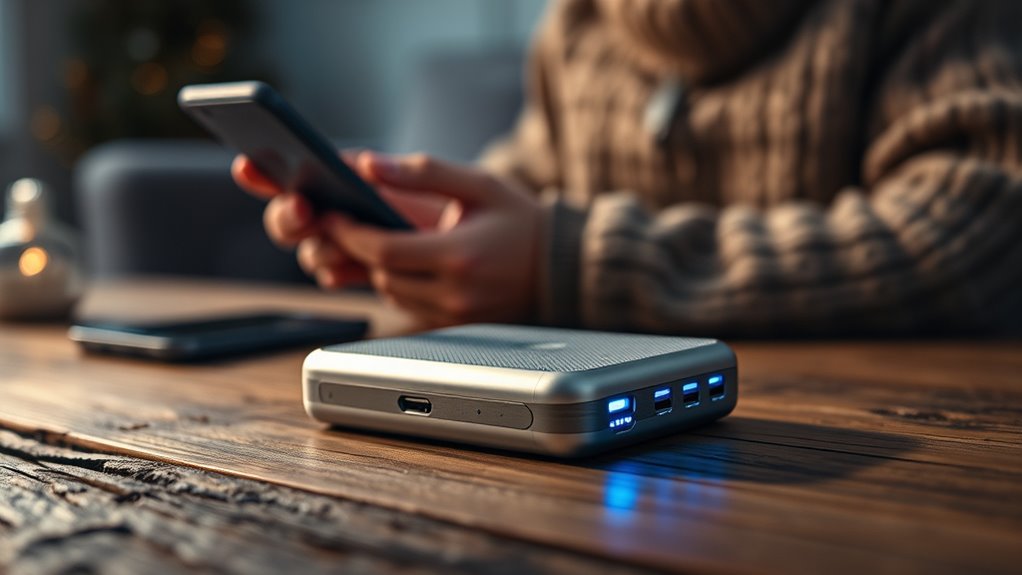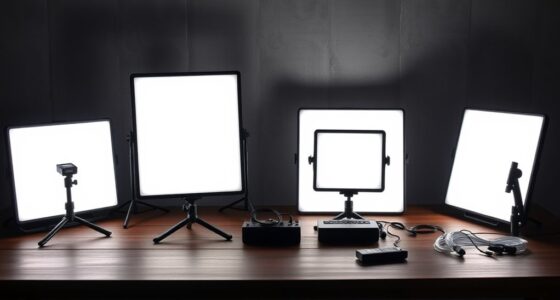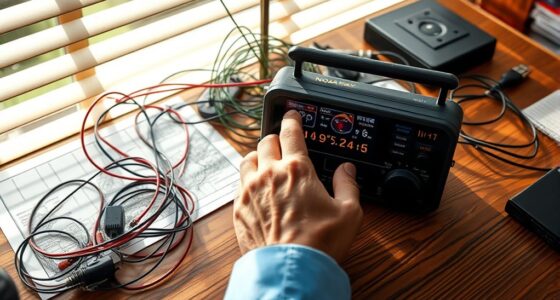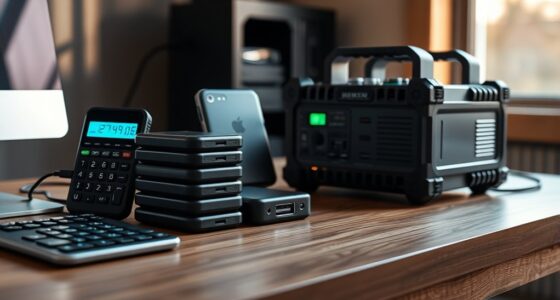During extended blackouts, maintaining portable battery power is vital to keep your devices connected and functioning. To do this, choose high-capacity batteries that match your energy needs and use solar panels for recharging, especially during sunny days. Prioritize essential devices and use energy-efficient options to conserve power. Support pass-through charging so you can use and recharge at the same time. For more practical tips on staying powered up, keep exploring further.
Key Takeaways
- Use high-capacity portable batteries with sufficient watt-hours to ensure longer power availability during extended outages.
- Incorporate solar charging capabilities, utilizing solar panels for sustainable recharging without grid dependence.
- Prioritize essential devices and adopt energy-efficient practices to conserve battery power effectively.
- Monitor battery levels regularly and support pass-through charging to use and recharge simultaneously.
- Select batteries with fast-charging and MPPT technology for quicker, more efficient solar recharging in sunlight.

During a blackout, having a portable battery can be a lifesaver, guaranteeing you stay connected and powered up when the grid goes down. When you’re relying on a portable power source, understanding the importance of solar charging and battery capacity becomes essential. Solar charging offers an eco-friendly and independent way to replenish your battery, especially during extended outages when traditional power sources are unavailable. By using solar panels, you can harness sunlight to recharge your portable battery, reducing your dependence on grid power and guaranteeing you maintain a continuous power supply.
Battery capacity plays a vital role in how long your portable power will last during a blackout. The higher the capacity, the more energy it can store, allowing you to run critical devices such as phones, medical equipment, or small appliances for an extended period. When selecting a portable battery, consider your energy needs carefully. For instance, if you need to charge your smartphone multiple times or power a small fridge, opt for a battery with a higher watt-hour rating. This guarantees you have enough power to meet your needs without constantly worrying about recharging.
If you’re planning to rely on solar charging, it’s wise to invest in a portable battery with a fast-charging capability and compatibility with solar panels. Some batteries come with built-in MPPT (Maximum Power Point Tracking) technology, which optimizes solar input and improves charging efficiency. During daylight hours, you can connect portable solar panels directly to your battery, allowing for continuous recharging during sunny days. This setup is especially valuable in prolonged outages, giving you a sustainable solution that doesn’t drain your stored energy.
Managing your battery’s capacity is also about conserving power. You should prioritize essential devices and avoid unnecessary energy drain. Use energy-efficient devices whenever possible, and turn off anything not in use. Regularly monitor your battery’s charge level to prevent it from completely depleting, which can reduce its lifespan. If your battery supports pass-through charging, you can use it while it’s being recharged by solar, maximizing uptime. Additionally, understanding your energy needs and planning accordingly can help you select the right battery size and usage strategy.
Ultimately, maintaining portable battery power during extended blackouts requires a strategic approach. Focus on choosing a battery with sufficient capacity, leverage solar charging to keep it topped up, and practice energy conservation. This way, you’ll guarantee a reliable power backup that keeps your critical devices operational, providing peace of mind during challenging times.
Frequently Asked Questions
How Long Can a Portable Battery Reliably Power Devices During a Blackout?
A portable battery can reliably power your devices for several hours to days, depending on its battery capacity and device compatibility. Larger capacity batteries, like 20,000mAh or more, can keep smartphones, tablets, and small appliances running longer. To maximize runtime, choose a battery that matches your device’s power needs and avoid overloading it. Always keep your battery charged and consider having a backup for extended blackouts.
Are There Specific Batteries Better Suited for Long-Term Blackout Use?
Imagine you’re preparing for a prolonged blackout. You should choose batteries with high capacity and longevity, like deep-cycle AGM or lithium-ion models. These batteries are designed to sustain power over extended periods, making them ideal for long-term use. Their larger capacity guarantees longer runtime, and their durability preserves performance over many cycles. Investing in such batteries helps you stay powered reliably during extended outages.
How Should I Store My Portable Battery to Maximize Lifespan?
To maximize your portable battery’s lifespan, store it in a cool, dry place away from direct sunlight. Proper battery storage involves maintaining an essential charge level—around 50%—and avoiding extreme temperatures. Temperature management is vital, so keep it in a stable environment to prevent capacity loss. Regularly check and recharge the battery as needed, especially if you won’t use it for a while, ensuring it stays in good condition for long-term blackout preparedness.
Can Portable Batteries Be Recharged With Alternative Power Sources?
Yes, you can recharge portable batteries with alternative power sources like solar recharging and wind power. You simply connect your battery to compatible solar panels or wind turbines, allowing renewable energy to replenish it. This is especially useful during extended blackouts when traditional power sources aren’t available. Make sure your battery supports these methods and follow manufacturer instructions to ensure safe and efficient recharging.
What Safety Precautions Should I Take When Using Portable Batteries for Extended Periods?
Did you know that improper battery safety can increase fire hazards by up to 25%? When using portable batteries for extended periods, always keep them in a cool, dry place and avoid overcharging. Never cover vents or expose them to heat. Use the right charger and follow manufacturer instructions carefully to prevent fire hazards and guarantee safe, reliable power during blackouts. Stay vigilant to protect yourself and your home.
Conclusion
To keep your energy flowing like a steady river during extended blackouts, never underestimate the power of a reliable portable battery. Think of it as your personal lighthouse, guiding you safely through the darkness. With it, you hold a beacon of hope, ensuring your devices stay alive and connected. Stay prepared, and you’ll turn a blackout into just a temporary shadow, knowing your portable power is always ready to light your way when the night falls.









